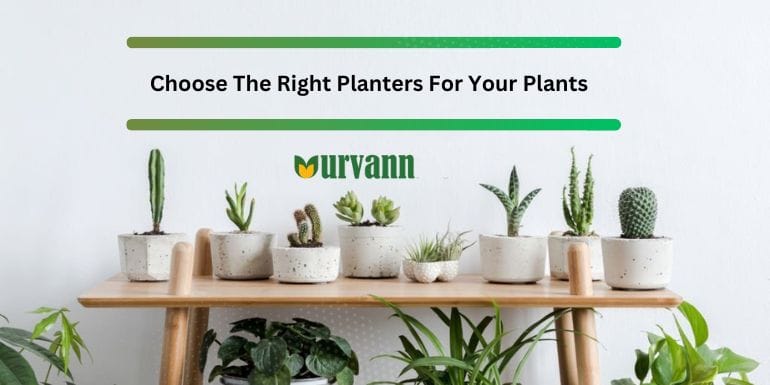Why do you need to select the right planter for every plant?
Choosing the right planter for your plant is imperative to its healthy growth. The material, shape and size you pick will determine the amount of water retention, how much space the roots will get and how quickly the plant grows.
There are 3 major types of pot materials, namely-
1. Clay or Terracotta pots
2. Ceramic Planters
3. Plastic Planters
Pros & Cons of Pots
Let us walk you through the advantages and disadvantages of each type of pot.
Terracotta:
Pros-
Water Absorption: Terracotta or earthen mitti pots absorb water and therefore prevent waterlogging in plants. This saves your plants from root rot and keeps them healthy by providing proper aeration.
Traditional Decor: Terracotta pots have been used since ages in India. These give your garden or home a traditional indian look. Besides this, you also support local artisans by purchasing terracotta pots.
Temperature Regulation: These pots regulate soil temperature especially in summers by providing the soil from getting too hot and saving the roots.
Eco Friendly: Terracotta pots are eco friendly and biodegradable as they are made from natural substances.
Cons-
Difficult to Move: These pots are considerably heavy and hence difficult to move around for cleaning or restructuring.
Water Absorption and Evaporation: Water tends to evaporate easily from these pots thereby requiring frequent watering. These pots are most suitable for drought tolerant plants.
Fragile: Despite being heavy, these planters are fragile and prone to breakage if they fall.
Ceramic Pots-
Pros-
Retains Moisture: Ceramic planters have better moisture retention compared to terracotta, reducing the frequency of watering.
Variety: Ceramic pots come in a variety of shapes, sizes as well as colours and textures suitable for all types of plants.They are suitable for indoor plant pots.
Aesthetic: These pots are used by a lot of people to give their home and plants a polished and elegant look.
Durability: High-quality ceramic planters can be quite durable, with good resistance to weathering and fading over time.
Cons-
Difficult to Move: Just like terracotta pots, these planters are also heavy in weight and can be difficult to move.
Cracks: Ceramic pots that have not been fired properly can tend to crack and break.
Expensive: Ceramic planters tend to be more expensive than terracotta or plastic options, particularly for high-quality designs.
Plastic Planters-
Pros-
Lightweight: These plants are very lightweight and can be moved around easily allowing for better cleaning. Due to their lightweight nature, they make for great hanging planters for a vertical garden.
Affordable: Plastic planters are easily the most affordable option for those on a budget.
Durability: Plastic planters are resistant to cracking, chipping, and fading, and they can withstand various weather conditions.Due to this, they are suitable to be used as outdoor plant pots or plastic flower pots.
Moisture Retention: Plastic does not allow water to evaporate easily thus making water retention easy. These pots are suitable for most plants.
Cons-
Non-Biodegradable: Plastic is not an eco friendly material and hence not good for the environment.
Heat Retention: Plastic can retain heat more than other materials, potentially leading to overheating of the soil in hot climates.
Aesthetic Appeal: Plastic planters are not considered to be aesthetically pleasing by some people. However, they can be kept inside jute bags for a boho look.
Pots & Planter Benefits:
Pest Control: Since pots create a physical barrier between the ground and the plant, it prevents the plant from getting multiple diseases and pests from the ground and other plants.
Appropriate Space: By providing dedicated planters for a plant, it allows us to give the right amount of space for the plant to grow and prevent it from competing for nutrients.
Aesthetic Appeal: Planters and pots come in a wide range of styles, materials, and designs, allowing you to enhance the visual appeal of your indoor or outdoor space. They can complement your overall decor and create a more inviting and cohesive environment.
Maintenance: Keeping plants in enclosed spaces allows for easier watering, fertilisation and general maintenance. Planters maintenance can be ensure by having appropriate drainage holes and dusting and cleaning the planters regularly.
Conclusion:
It is helpful to keep plants in pots and planters as this helps with pest control, space management as well as increases the aesthetic appeal. Moreover, planters allow for urvan gardening where space is less.
There is no one answer to the best type of planter as it highly depends on the plants. A terracotta planter might be suitable for plants like bougainvillea and succulents while a ceramic planter might be suitable for pothos. The size of the planter should also be carefully selected depending on the size of the plant. One should avoid using too big or too small pots. Grow bags are also suitable for most plants and are frequently used for vegetable gardens.
Frequently Asked Questions
What type of planter is best for plants?
There is no universally best planter. Each plant’s needs will determine the right material, shape as well as size suitable for it.
What type of planter lasts the longest?
Ceramic and fiberglass planters are some of the longest lasting pot options available.
What shape of pots are best for plants?
Pots come in different shapes sizes and there is no uniform best shape. However, cylindrical shapes or other shapes with a broader top allow for easy repotting without damaging the roots.
What color planter is best?
Planters come in different colours and the best colour completely depends on your decor.
What is the best height for planters?
Each planter’s height depends on the size of the plant. For example, tall plants like areca palm require taller planters while succulents require very small table-top planters.


0 Comment